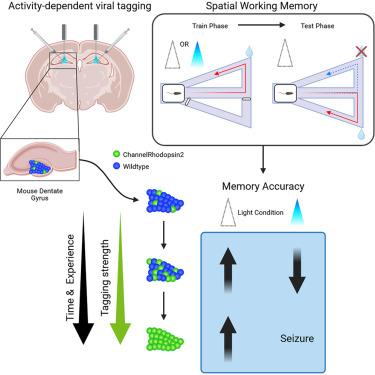Nonspecific ensemble reactivation in mouse dentate gyrus disrupts spatial working memory
IF 4.1
2区 综合性期刊
Q1 MULTIDISCIPLINARY SCIENCES
引用次数: 0
Abstract
Spatial working memory enables behavioral flexibility and depends upon the hippocampus. The hippocampal dentate gyrus (DG) is hypothesized to act as a pattern separator to disambiguate similar memories. We used activity-dependent labeling strategies in DG to tag multiple memory-associated neuronal ensembles recruited during the course of learning a spatial working memory task. We termed the tagged ensembles “nonspecific” because they arose from experiences across days, maze arenas, and the home cage. Optogenetic stimulation of nonspecific ensembles during the encoding phase within random trials of the task acutely impaired performance during light-on trials only. The degree of reactivation in the dentate hilus, but not the blade, inversely correlated with task accuracy. While our results do not rule out the possibility that the stimulation of random, sparse DG ensembles could lead to similar impairment, they are consistent with the proposed role of DG in pattern separation, completion, and spatial working memory.

小鼠齿状回非特异性集合再激活破坏空间工作记忆
空间工作记忆使行为具有灵活性,并取决于海马体。海马体齿状回(DG)被假设为一种模式分离器来消除相似记忆的歧义。我们在DG中使用活动依赖标记策略来标记在学习空间工作记忆任务过程中招募的多个记忆相关神经元群。我们将标记的集合称为“非特异性”,因为它们来自于白天、迷宫竞技场和家庭笼子的经历。在随机试验中,仅在光照试验中,在编码阶段对非特异性集合进行光遗传刺激会严重损害任务的表现。齿状门的再激活程度与任务的准确性呈负相关,而不是刀刃。虽然我们的研究结果不排除随机、稀疏的DG集合刺激可能导致类似损伤的可能性,但它们与DG在模式分离、完成和空间工作记忆中的作用是一致的。
本文章由计算机程序翻译,如有差异,请以英文原文为准。
求助全文
约1分钟内获得全文
求助全文
来源期刊

iScience
Multidisciplinary-Multidisciplinary
CiteScore
7.20
自引率
1.70%
发文量
1972
审稿时长
6 weeks
期刊介绍:
Science has many big remaining questions. To address them, we will need to work collaboratively and across disciplines. The goal of iScience is to help fuel that type of interdisciplinary thinking. iScience is a new open-access journal from Cell Press that provides a platform for original research in the life, physical, and earth sciences. The primary criterion for publication in iScience is a significant contribution to a relevant field combined with robust results and underlying methodology. The advances appearing in iScience include both fundamental and applied investigations across this interdisciplinary range of topic areas. To support transparency in scientific investigation, we are happy to consider replication studies and papers that describe negative results.
We know you want your work to be published quickly and to be widely visible within your community and beyond. With the strong international reputation of Cell Press behind it, publication in iScience will help your work garner the attention and recognition it merits. Like all Cell Press journals, iScience prioritizes rapid publication. Our editorial team pays special attention to high-quality author service and to efficient, clear-cut decisions based on the information available within the manuscript. iScience taps into the expertise across Cell Press journals and selected partners to inform our editorial decisions and help publish your science in a timely and seamless way.
 求助内容:
求助内容: 应助结果提醒方式:
应助结果提醒方式:


